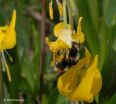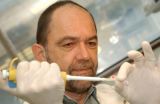(Press-News.org) Cancer is a difficult disease to treat because it's a personal disease. Each case is unique and based on a combination of environmental and genetic factors. Conventional chemotherapy employs treatment with one or more drugs, assuming that these medicines are able to both "diagnose" and "treat" the affected cells. Many of the side effects experienced by chemotherapy patients are due to the fact that the drugs they are taking aren't selective enough. For instance, taking a drug that targets fast-growing tumor cells frequently results in hair loss, because cells in the hair follicle are among some of the fastest growing in the body. When it comes down to it, these drugs get the diagnosis wrong.
But what if we had cancer treatments that worked more like a computer program, which can perform actions based on conditional statements? Then, a treatment would kill a cell if --and only if-- the cell had been diagnosed with a mutation. Only the defective cells would be destroyed, virtually eliminating unwanted side effects.
With support from the National Science Foundation (NSF), researchers at the California Institute of Technology have created conditional small RNA molecules to perform this task. Their strategy uses characteristics that are built into our DNA and RNA to separate the diagnosis and treatment steps.
"The molecules are able to detect a mutation within a cancer cell, and then change conformation to activate a therapeutic response in the cancer cell, while remaining inactive in cells that lack the cancer mutation," claims Niles Pierce, co-author of a recent study which appears in the September 6 issue of Proceedings of the National Academy of Sciences (PNAS).
This work is part of the Molecular Programming Project, funded by NSF's Directorate for Computer & Information Science & Engineering. One of the goals of the project is to increase understanding of how information can be stored and processed by molecules, and how we might create practical applications that utilize that information.
At the heart of this approach is ribonucleic acid or RNA, and all of the normal tasks it performs each and every day to keep our cells alive and healthy. RNA is the relatively short-lived counterpart of DNA, the coding system that stores full copies of our entire genome within almost every cell of our body. If we think of DNA as information stored on the hard drive of a computer, then RNA is like information stored on a more volatile kind of memory like RAM -- which is erased when you switch off your computer.
RNAs perform all kinds of functions in a cell, acting as messengers and switches to communicate and monitor which genes are expressed in a cell at any given time. A particular class of RNAs, called small RNAs, is less than 30 base pairs in length (an average gene is thousands of base pairs long). These small bits of RNA are involved in many of the processes that maintain life. The treatment developed by Pierce and his colleagues relies on two separate small RNAs that structurally mimic those that occur naturally within our own cells. Because these molecules resemble small RNAs that are normally present, the researchers hope there will be few, if any side effects.
"By de-coupling diagnosis and treatment, we can create molecules that are both highly selective and highly effective in killing cancer cells," said Pierce. "Conceptually, small conditional RNAs have the potential to transform cancer treatment because they change what we can expect from a molecule. Many years of work remain to establish whether this conceptual promise can be realized in human patients."
Here's how it works: Treatment involves two different small RNAS. The first small RNA will open up if --and only if-- it finds the cancer mutation. A positive "diagnosis" exposes a signal that was previously hidden within the small RNA. Once this small RNA is open, a second small RNA binds to it, setting off a chain reaction in which these RNA molecules continue to combine to form a longer chain. The length of the chain is an important part of the "treatment". Longer chains trick the cell into thinking it has been invaded by a virus, tripping a self-destruct response.
In the PNAS study, researchers demonstrated that this approach effectively eliminates lab-grown human brain, prostate and bone cancer cells in a mutation-specific manner. Future experiments will determine whether the treatment is effective on a larger scale.
INFORMATION:
The recession is finally taking its toll on national, state and local unionization rates, according to UCLA's annual report on organized labor.
Following an uptick last year, unionization rates fell between July 1, 2009, and June 30, 2010, by just more than half a percentage point in California and by a full percentage point in the five-county Los Angeles metropolitan area, researchers at UCLA's Institute for Research on Labor and Employment (IRLE) found.
"Given the duration and depth of the recession, it was inevitable that union jobs would be hit," said Lauren ...
Plaque-causing bacteria can jailbreak from the mouth into the bloodstream and increase your risk of heart attack says a scientist at the Society for General Microbiology's autumn meeting in Nottingham.
Professor Howard Jenkinson, from the University of Bristol explains how oral bacteria can wreak havoc if they are not kept in check by regular brushing and flossing. "Poor dental hygiene can lead to bleeding gums, providing bacteria with an escape route into the bloodstream, where they can initiate blood clots leading to heart disease," he said.
Streptococcus bacteria ...
Selfish bacterial cells that act in their own interests and do not cooperate with their infection-causing colleagues can actually reduce the severity of infection.
The selfish behaviour of these uncooperative bacteria could be exploited to treat antibiotic-resistant infections, according to research being presented at the Society for General Microbiology's autumn meeting today.
Bacteria work together by using a well-studied communication system called Quorum Sensing (QS). During infection, bacteria talk to each other using QS to coordinate the release of toxins.
Researchers ...
While we are often exposed to bacteria in our food which could cause food poisoning, we don't always become ill - why should this be so?
Professor Colin Hill who is presenting his work at the Society for General Microbiology's autumn meeting in Nottingham today describes how bacteria use different tricks to aid their survival inside the body, helping to explain why food poisoning can be so unpredictable.
One of the biggest challenges faced by food-borne bacteria is acid. Acidic conditions, particularly in the stomach and in the gut will kill most microbes found in contaminated ...
TORONTO, ON - Widespread reports of a decline in the population of bees and other flower-visiting animals have aroused fear and speculation that pollination is also likely on the decline. A recent University of Toronto study provides the first long-term evidence of a downward trend in pollination, while also pointing to climate change as a possible contributor.
"Bee numbers may have declined at our research site, but we suspect that a climate-driven mismatch between the times when flowers open and when bees emerge from hibernation is a more important factor," says James ...
STOCKHOLM (6 September 2010)—Against a backdrop of extreme weather wreaking havoc around the world, a new report warns that increasingly erratic rainfall related to climate change will pose a major threat to food security and economic growth, especially in Africa and Asia, requiring increased investment in diverse forms of water storage as an effective remedy.
"Millions of farmers in communities dependent on rainfed agriculture are at risk from decreasing and erratic availability of water," said Colin Chartres, director general of the Sri Lanka-based International Water ...
CAMBRIDGE, Mass. -- Plants are good at doing what scientists and engineers have been struggling to do for decades: converting sunlight into stored energy, and doing so reliably day after day, year after year. Now some MIT scientists have succeeded in mimicking a key aspect of that process.
One of the problems with harvesting sunlight is that the sun's rays can be highly destructive to many materials. Sunlight leads to a gradual degradation of many systems developed to harness it. But plants have adopted an interesting strategy to address this issue: They constantly break ...
SANTA CRUZ, CA--A tiny optical device built into a silicon chip has achieved the slowest light propagation on a chip to date, reducing the speed of light by a factor of 1,200 in a study reported in Nature Photonics (published online September 5 and in the November print issue).
The ability to control light pulses on an integrated chip-based platform is a major step toward the realization of all-optical quantum communication networks, with potentially vast improvements in ultra-low-power performance. Holger Schmidt, professor of electrical engineering in the Baskin School ...
One of the key drivers of human evolution and diversity, accounting for changes that occur between different generations of people, is explained by new research published today (Sept 5) by world-renowned scientist Professor Sir Alec Jeffreys, who discovered DNA fingerprinting at the University of Leicester.
Professor Jeffreys has spent over two decades since his landmark discovery in 1984 investigating what he describes as "pretty bizarre bits of DNA" - highly variable repeated parts of DNA called 'minisatellites' - found in the human genome. Sir Alec observed that ...
Biologists at the University of California, San Diego have discovered that a gene critical for programmed cell death is also important in the loss of adult stem cells, a finding that could help to improve the health and well-being of patients undergoing cancer treatment.
"During chemotherapy or radiation therapy that kills cancer cells by inducing significant DNA damage in their genomes, one of the main side effects for human cancer patients is the depletion of their own adult stem cells, particularly the ones responsible for making new blood and intestine cells. So these ...



